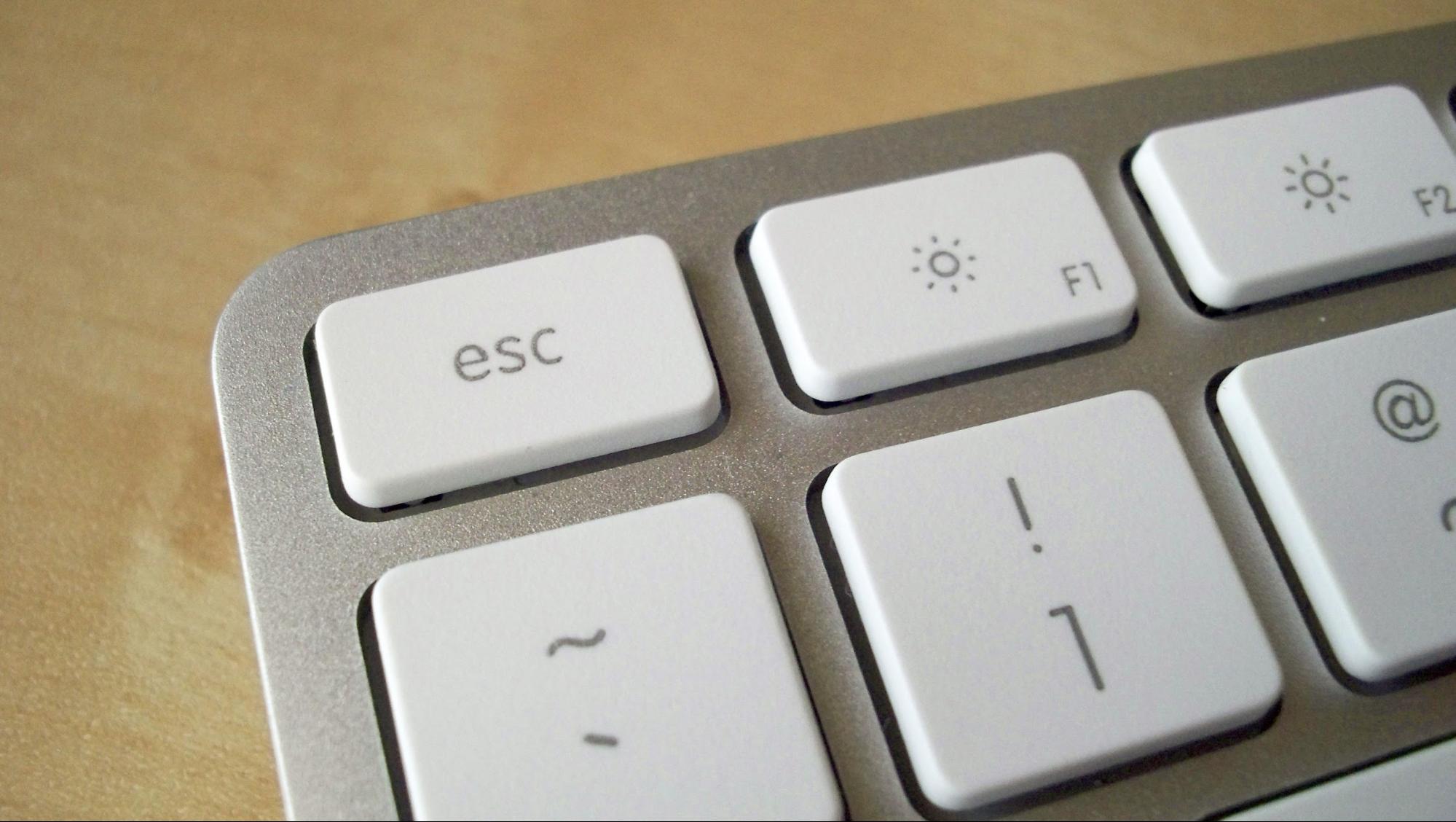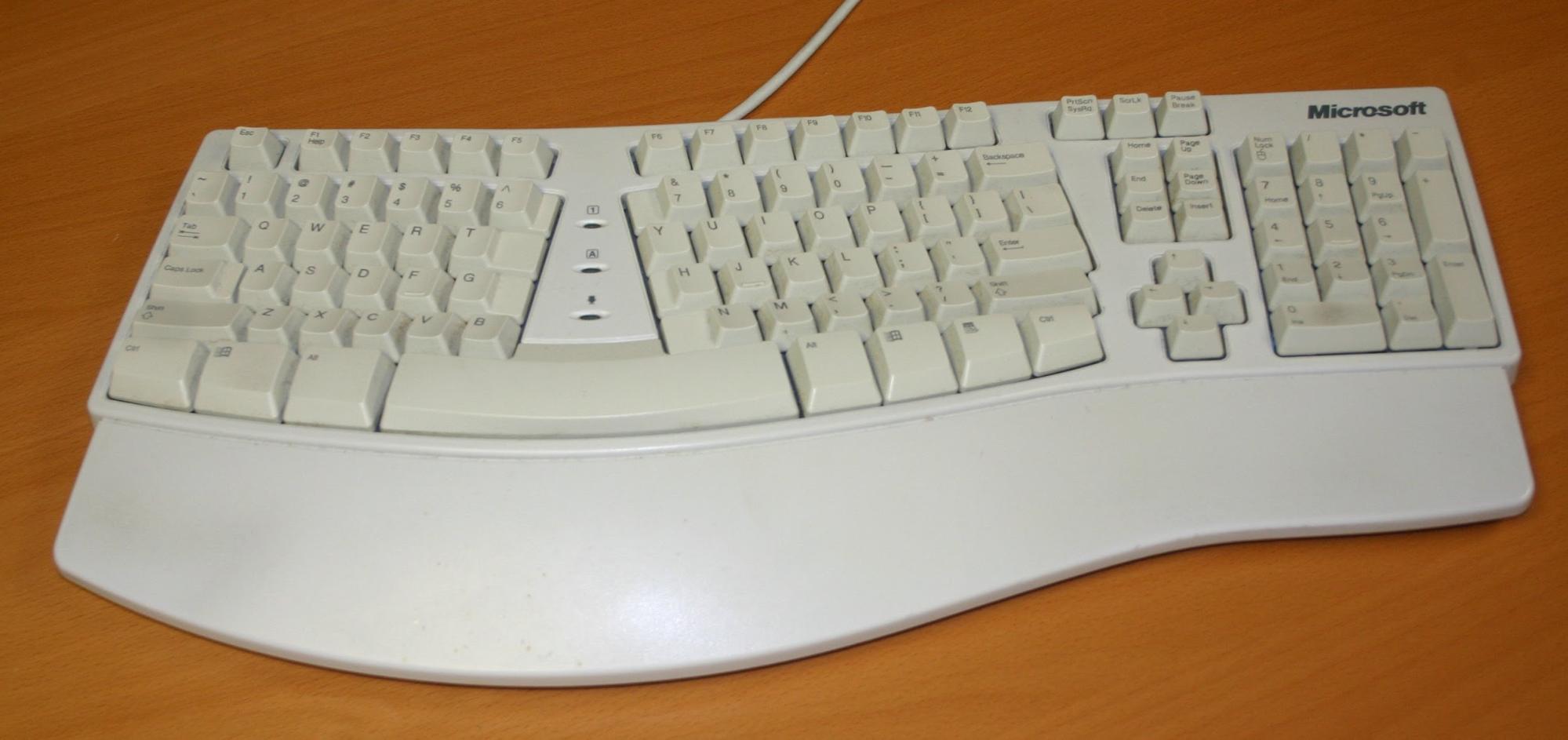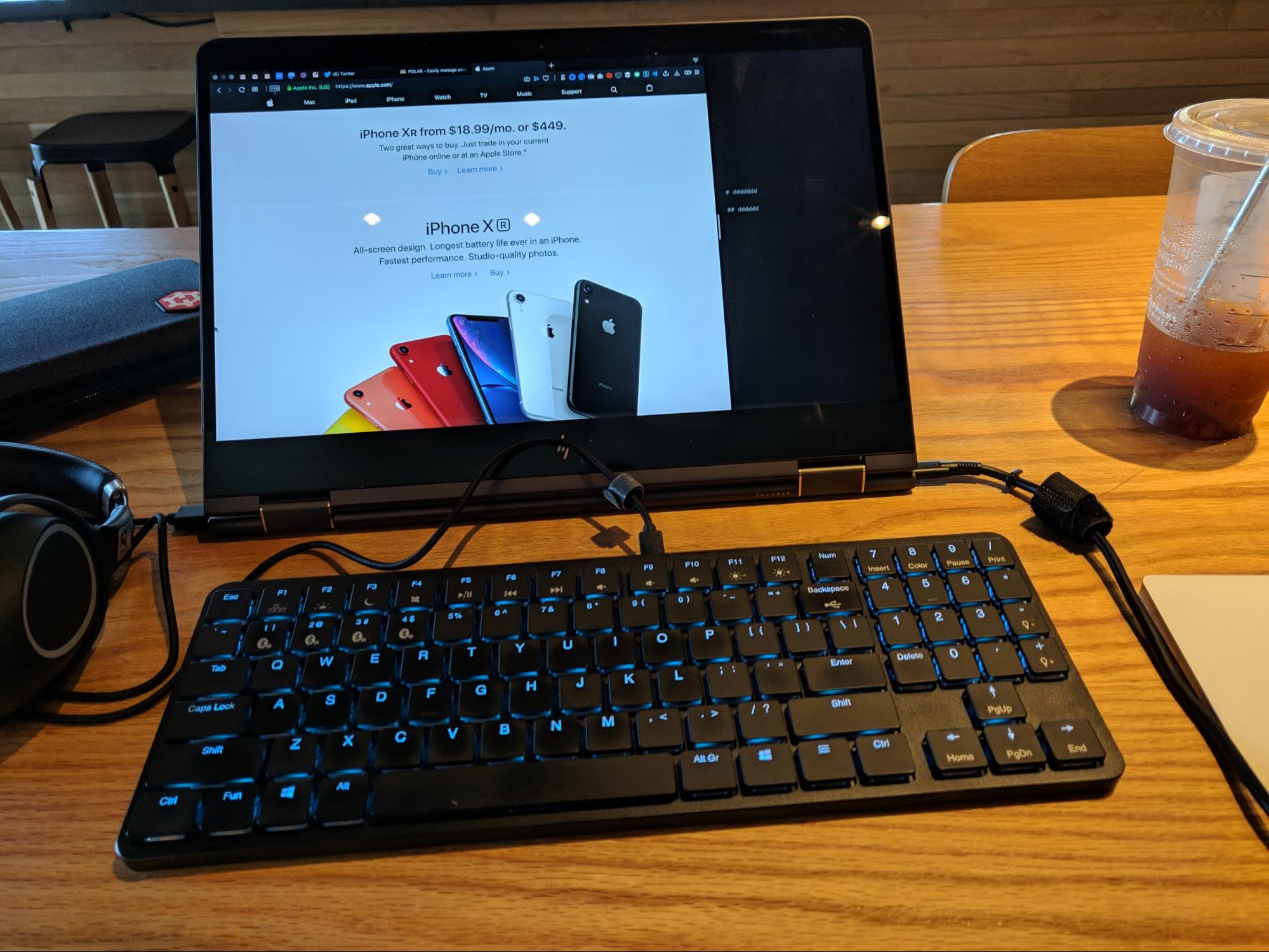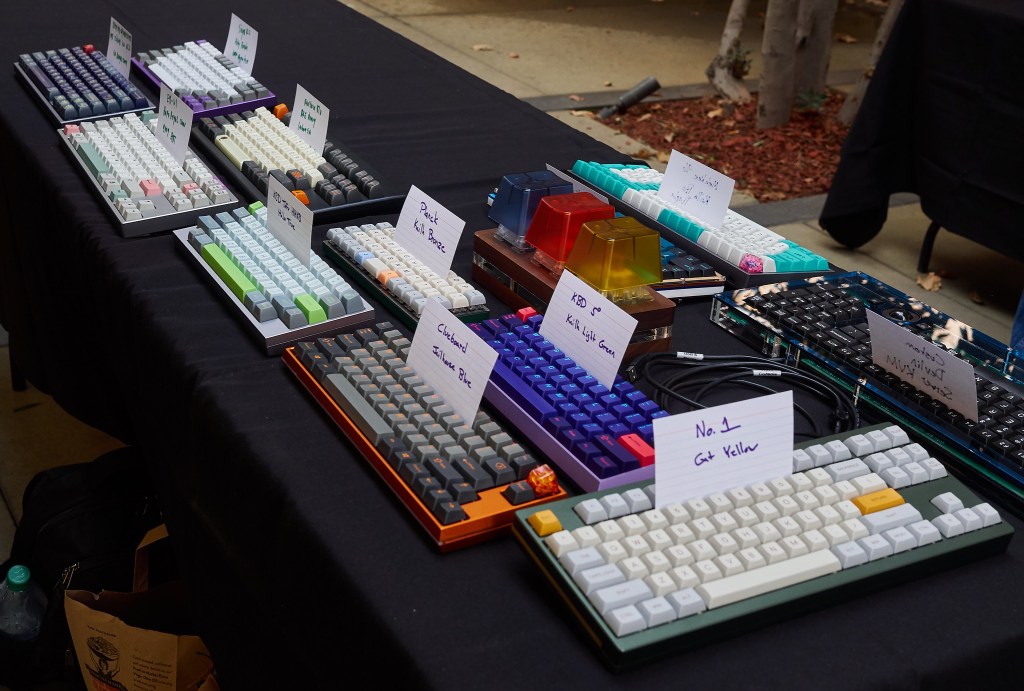A version of this post originally appeared on Tedium, a twice-weekly newsletter that hunts for the end of the long tail.
For years, it’s felt like the big guys in the tech industry were the ones doing the riskiest, most innovative things—mainly because they had the budgets, resources, and the technical know-how to pull it off.
Videos by VICE
But in the past few years, it seems like things are tipping in the other direction. The bespoke folks, enabled by smaller computers (such as the Raspberry Pi) and lower barriers to entry, are starting to take on some of that risk.
Especially in areas the big guys have sort of pushed to the side. Like keyboards, a space where the thinner and lighter at all costs equation starts to break down.
Why are the little guys are driving all the excitement in keyboards these days? Let me explain.

Why did big companies fall out of love with great desktop keyboards?
In 2004, Sony released a Vaio-branded laptop that most people have probably forgotten about but nonetheless casts a large shadow over modern computing.
The X505, in its efforts to take thinness to the extreme for the time, came up with a new approach to keyboards that was quickly emulated throughout the industry: It used scissor-switch based keys to press down on rubber domes, and put flat, chiclet-style keycaps on top of those switches. It kept the key relatively firm while still ensuring flatness.
If you’ve typed on a laptop keyboard in the past 15 years, you’ve likely used a descendant of this design, which effectively was a 2004 take on the 2011 MacBook Air.
“Before then, chiclet keyboards were evil, rubbery things,” notes Boing Boing’s Rob Beschizza. “But that changed at about that time, and Sony was in the vanguard.”
It was great news for laptops. The scissor switch is a perfectly fine option for laptops where space is a luxury.
Unfortunately, that switch ended up getting used on a bunch of keyboards that weren’t attached to laptops. The fact that it seems to have driven some mainstream computer makers away from providing cushier keyboard experiences when vertical space isn’t at a luxury is unfortunate.
Early PC keyboards were both heavy and extremely definitive in keyfeel—the IBM Model M, with its buckling springs, was a beast compared to the simplistic and minimal Apple Magic Keyboard, for example. But while taking up less room on your desk, lower-profile keyboards sacrificed a lot to get there—including heft, key actuation, and ergonomics. Some have blamed the overly flat, thin aesthetic of scissor-switch desktop keyboards for giving them repetitive stress injuries, but the biggest knock on these keys is their feel—with less space, there’s less clickiness, and keys “bottom out” with much less force. When using a laptop, sacrifices often need to be made; using a desktop setup requires none of those sacrifices, yet we’re making them anyway.
It’s as if the goal is less how it functions and more how it looks, an admission of sorts that the people who care about things such as really good keyboards just aren’t that prominent a user base anymore. Why give them a five-star experience when the average user is perfectly fine with two stars?
If there was a time when mainstream companies truly cared about computer keyboards, it was probably in 1994, when Microsoft decided to start selling the Natural Keyboard, an ergonomic keyboard, as one of its first pieces of hardware—and then priced it at less than $100.

It was just as beige as everything else in 1994, which means that if you buy one today, you should expect more than a little yellowing on those old keys. But it stood out as a statement piece because of its ergonomic design. It had a giant lump in the middle that essentially forced your hands into a more ergonomic stance.
No matter your opinion of Windows, Word, or DOS, you could find something to love about Microsoft’s Natural Keyboard. And a lot of people did—the company sold 3 million units of the original model in the span of a few years, an impressive number given the fact that most computers already came with keyboards.
I’m not saying that the Natural Keyboard was perfection—certainly, there were better keyboards at higher price points on the market, and the keyboard used less-heralded rubber domes rather than mechanical key switches—but it was the kind of keyboard that people used for decades and only replaced because it literally stopped working.

Unfortunately, the virus of minimalism, which did a lot of good in other parts of the tech field, ultimately put its daggers into the desktop keyboard, leading to designs that were the very definition of form over function. The most egregious example of this I can think of is the fact that Apple at one point sold perhaps the best keyboard ever made with rubber dome switches, the highly curved A1048 keyboard, and replaced it with an utterly flat chiclet design that seems designed with almost no consideration for ergonomics. Good for product shots! Not so great for people typing more than 3,000 words a day.
Even Microsoft, which had generally created some pretty good mainstream desktop keyboards over the years, eventually fell into the minimalism trap. Its most recent variants on the Natural Keyboard, the Surface Ergonomic Keyboard and the Sculpt keyboard, combine the chiclet style with the famed bulge of its earlier split keyboards. I’m sure there are fans of these keyboards; I wonder if they know what they’re missing.
Certainly, some segments of the market are better served than others. Gamers, for example, rely on those mechanical switches to really press things forward; those users have probably done more to keep the memory of the Cherry MX switch alive than anyone else. (Which probably explains why firms that have traditionally catered to gamers, like Corsair and Razer, have proven one of the few mainstream through lines that the mechanical keyboard has.)
But when it comes to mainstream computer use, one has to wonder if, in our fight for thinness, we’ve sacrificed things that used to matter to users, such as usability, all for aesthetic design. You can generally make the case for something like a Surface or a modern laptop to have a thin keyboard, but there is literally no reason that desktop keyboards need to be as thin as they are, outside of reasons of appearance.
The backlash against the MacBook Pro’s butterfly keyboard, with its surprisingly “low” failure rate, has been useful for end users who felt that key travel had finally been sacrificed too much in the long battle for lower weight. While it remains to be seen if Apple will switch back to a scissor switch, it’s at least prevented other manufacturers from following suit, much the way Sony’s work on chiclet keys quickly spread across the industry and much the way that many of Apple’s decisions on the 2011 MacBook Air influenced everyone else’s designs.
But what about desktop keyboards—will they finally reach a happy medium once again? Perhaps the goal should be to look beyond the mainstream.

Why keyboards are particularly well-suited for bespoke experimentation
So, to put this another way, many mainstream computer manufacturers—especially those focused on appearance rather than hardware function—have left the desktop keyboard behind.
That’s the bad news. The good news is that it’s created room for players who work on smaller scales, but who target more passionate communities of users.
Because the folks in these communities have noticed this dumbing down, too. In a blog post from earlier this year, Andrew Lekashman, a cofounder of the keyboard enthusiast community Input Club, put mainstream technology’s dumbing-down of the keyboard into stark terms:
Keyboards regressed in quality over the last 30 years. Cost cutting and planned obsolescence were the main motivators for its decline, which sacrificed user experience in exchange for profit margins. Keyboards were essentially feature-stagnant, excluding mobile touchscreens and decorative lighting for gamers. Any developments in the mainstream market made keyboards thinner, a decision based on aesthetics and material cost rather than functionality.
Input Club, founded by a group of fans of input devices, was built around the general idea of introducing new thinking to the keyboard space. Why, specifically, keyboards? In an interview, Lekashman noted that keyboards often have much more flexibility to be experimented with and modified than other parts of a computing experience.
“One of the key things is they’re big,” Lekashman said in an interview. “And they’re actually kind of the bridge that you use to do most everything with a computer.”
Keyboards have a lot of individual parts, and they allow for a lot more modification than many other parts of the computing experience. Customization of this nature is often the realm of other hobbies—such as cars, where Lekashman highlights some clear parallels.
“When it comes to being a car nerd, you have to have a lot of money if you want to try a bunch of different cars, or you have to hang out with other car nerds and borrow their car,” he explained. “But when it comes to keyboards, you don’t actually have to be that rich to go get 10 different keyboards and be able to use a different one every week or whatever.”
Input Club caters to folks who might not be able to afford to tinker with fancy cars, but looove messing around and experimenting with new ideas in fancy keyboards—and are excited enough by the concept that they’re ready to pick up a soldering iron and built the keyboard of their dreams directly from a kit.
Of course, not everyone is ready to solder their own keycaps—what about folks who simply want to use nice keyboards? Input Club has that community covered through a handful of related endeavors, including Kono Store, which sells both full-fledged keyboards and individual kits that target both enthusiasts and the broader keyboard market.
Do mechanical keyboards make sense in coffee shops? Yes! Hands on with the Hexgears X–1
In many ways, Input Club has helped to create something of a jumping-off point to help spread new ideas about keyboards to a broader audience. And that jumping-off point has created opportunities of its own.
Recently, Lekashman has been working with the Chinese firm Hexgears to help introduce some of their keyboards to the American market. These keyboards, which are sold on the Kono Store website, are marketed as gaming keyboards, a term that can be seen as a shorthand for “gateway drug” in the keyboard space: These are, effectively, mechanical keyboards for people who are getting introduced to the concept.
“Most people discover the keyboard community through like buying Razer product or buying a Corsair product, and then they decide that they want to go deeper,” Lekashman explained.
But on the other hand, I don’t think mechanical keyboards should only be thought of as gaming devices. There’s also, I think, untapped room for mechanical keyboards among heavy writers—the kind of folks that are serious about their words but are likely the folks who have run into the biggest headaches with the move towards thin and light. They might still want thin and light even if they want their keys to actually feel like keys.
With that in mind, I’ve been testing out the X–1, a low-profile mechanical keyboard from Hexgears, for the past couple of months, actually. (Remember how I noted that keyboard enthusiasts are compared to car enthusiasts? The name is directly inspired by the Bell X–1, the aircraft that broke the sound barrier.)
Certainly, I’m not as focused on things as actuation—and instead prefer to highlight real-world use cases. But one thing I have been interested in is finding a keyboard that does better than a scissor switch when a different kind of typing experience is desired, but is small enough to fit in my bag and use in a portable setting without the keys being overwhelmingly loud. You know, like a coffee shop.

This is a place where a keyboard like the X–1 shines—its design is fairly muted, but if you want RGB color served with your keypresses, it very much does the trick there. My favorite use case for this keyboard is with my HP Spectre x360, a.k.a. the Hackintosh I wrote about for Motherboard back in April. As that laptop has a 2-in–1 design that allows the keyboard to flip back, I hide away the scissor switches that come with it and use the low-profile X–1 instead.
Now, about the keyswitches on the X–1: They use Kailh Choc low-profile switches, one of a few low-switch variants that have hit the market in recent years. They attempt to take the key action of a more traditional mechanical keyboard and put it in a smaller form factor, borrowing both from the popular Cherry MX switches and from the scissor switch-style approach. At 2.4 millimeters, key travel is above what you would get from a traditional laptop keyboard, but still short enough to allow for portability.
Now, it’s not my first rodeo with a low-profile mechanical keyboard—I’ve also used a Drevo Joyeuse in a similar context in the past—but one problem I’ve seen with low-profile key switches, which effectively try to compress full mechanical switches into smaller spaces, is that they don’t hold the keycaps on so snugly, which can make for a somewhat mushy typing experience as the keys move around a little when you’re pressing them. (The X–1 doesn’t face this problem, fortunately.)
The keyboard took on thousands of words like a champ, and with low-resistance red switches—which aren’t quite as clicky as other types of mechanical keyboard switches and generally tend to be favored by gamers—my typing didn’t rise above the fray in a coffee-shop setting, ensuring that my keypresses weren’t annoying my neighbors. The design was thin, but feature-packed, with the ability to switch between a number of connected Bluetooth devices a major plus.
There are areas where I can see improvement in the X-1—the black design has a tendency to pick up oils on the fingers (it also comes in white, in case that matters to you); the key caps could probably stand a little more curvature; and its short stature may not make it the best choice for the desk setup of someone who already uses full-fat switches—but overall, it’s perfect for people who either want to dip their toes into mech keys, or want an upgrade from a less-than-ideal laptop keyboard. (Looking at you, 2016 MacBook Pro owners.)
Recently, while I was at a coffee shop, I spotted a user whose laptop was literally bent—and severely so, to the point where it created a hard-to-ignore wobble when the user tapped away at those keys.
But despite this, the user appeared not to be struggling with the clear physical defect in their device, writing what was probably an important paper on a device that curved upwards on the sides. She was typing faster than me—and I type pretty fast!
That example is obviously extreme, but we put up with a lot when simply trying to do more basic tasks. All the drama around the MacBook Pro keyboards in recent months is a reminder that, when put in a position where our computing capabilities are compromised by external forces, often, we’ll buckle down rather than finding a plan B.
We’ll just live with a keyboard that has a tendency to repeat characters, just like we might lean a little too hard on a phone with a cracked screen, knowing that the cost to repair it might just be a little too high.
But there are those who get mad as hell and decide they can’t take it anymore. And those folks make mechanical keyboards.
Mechanical keyboards have increasingly found audiences in the mainstream, but one has to wonder if some of their ideas will spread upwards, to the same companies that eschewed these designs just a couple of decades prior.
But if they do, they might find competition, not from other major manufacturers, but from those communities of enthusiasts that are willing to take the kinds of risks with keyboards that the big guys simply used to.
Recently, Input Club launched a Kickstarter for the Keystone, a keyboard that uses a new type of mechanical keyboard switch that can adjust its firmness or toughness based on your key action. These new switch variants effectively combine electronic technology—they’re based on the Hall effect, which uses a magnetic sensor inside of the switch to detect motion without anything having to touch—with more traditional analog key motions (in other words, you can keep your old Cherry MX keycaps).
Hall effect-based switches (whose function is explained in this video) are not new technology, dating back to the 1960s, but their high cost of design made them impractical outside of industrial uses (think individual buttons that have to work, like at nuclear power plants). But it’s now 2019, and the Hall effect is making a comeback in keyboards by manufacturers big and small.
So why would you want to do this? Lekashman says that, beyond allowing customization (the Keystone uses AI to properly match the keyboard to the typist, and allows for different levels of key sensitivity on individual keys), it allows for even longer-lasting keys than existing solutions.
“The consequence of making a Hall effect thing that the keyboard lasts basically forever,” he says. “Because you’re no longer bending metal, you’re just moving a magnet up and down and sensing it. And so these things can watch for like a billion presses and just like never, ever die.”
The Keystone is on track to being a big deal—with 17 days to go in its Kickstarter, it’s well past its original $35,000 goal—and it’s likely that, if it’s successful, it could help bring the Hall effect to a bigger audience and lead to future key-press innovations. Clearly, we need ideas beyond the scissor switch and the Cherry MX when it comes to pressing buttons. This could help us form a lot more of them.
Input Club is just one community in a constellation of mechanical keyboard innovators—subreddits and sites like Geekhack and Deskthority have been spreading the keyboard gospel for a while, and some of the people in those communities are messing around with really innovative ideas that may find their way into your next keyboard. It feels like innovation through the grass roots.
For a while, it seemed like tech innovation flowed up rather than down, where the little guy’s big idea eventually found its way to the big stage. But then the little guys got really big, and they made it hard for the next generation of little guys to succeed.
But the big guys still get blind spots—and that creates new opportunities for the little guys. The mechanical keyboard is one of those opportunities in action.




